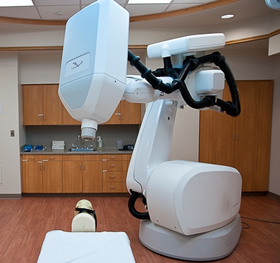by
Lauren Dubinsky, Senior Reporter | May 23, 2017

Accuray's CyberKnife at
UT Southwestern
Stereotactic partial breast radiation therapy requires only a few days of treatment and is just as safe as traditional radiation therapy, according to new research from UT Southwestern Medical Center.
Breast cancer is the most common cancer among women in the U.S., aside from skin cancers. The American Cancer Society estimates that about 252,710 new cases of invasive breast cancer will be diagnosed this year.
Standard radiation therapy is administered on a daily basis to the entire breast area for the course of three to six weeks. That can be overwhelming for patients who work full-time and/or have a family to take care of.
UT Southwestern's Harold C. Simmons Comprehensive Cancer Center is the only facility in Texas, and among the few in the world, to treat early-stage breast cancer patients with stereotactic partial breast radiation therapy.
When UT Southwestern opened its $66 million, 63,000-foot radiation oncology facility recently, one of its first purchases was Accuray's CyberKnife. The facility has dedicated areas for each major disease site such as breast, brain and gastrointestinal cancer.
For the study, the researchers studied 75 patients from 2010 to 2016 in whom stereotactic partial breast radiation therapy demonstrated excellent tumor control and cosmetic results. All of the patients were recently diagnosed with early-stage breast cancer.
One of the trial participants, Leslie LeBlanc, was diagnosed with early-stage breast cancer four years ago at the age of 47. She has two children and a full-time job.
Because her two sisters were previously diagnosed with breast cancer, she was already in a risk assessment program at UT Southwestern. She underwent mammograms and MR exams every six months, which helped to catch the disease at an early stage.
She only missed a few days from work upon undergoing stereotactic partial breast radiation therapy and she will reach her 5-year mark as a survivor next year.
"Mrs. LeBlanc is a working woman, a mom, and a wife. She's a great example of many women who will be impacted by this disease," Dr. Asai Rahimi, first author of the study, said in a statement. "We wanted to make this treatment more convenient for patients, because cancer is never convenient."
Rahimi and his research team plan to conducted additional studies to further investigate the partial breast radiation technique. The current study was published in the
International Journal of Radiation Oncology, Biology and Physics and was funded by a grant from Accuray.
Back to HCB News
